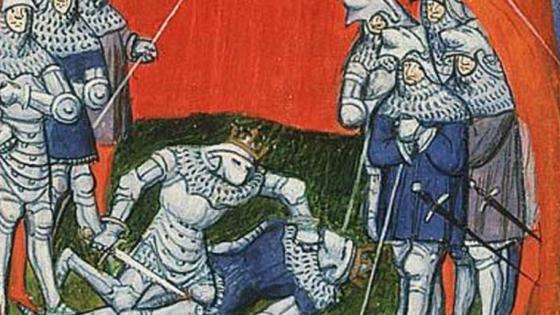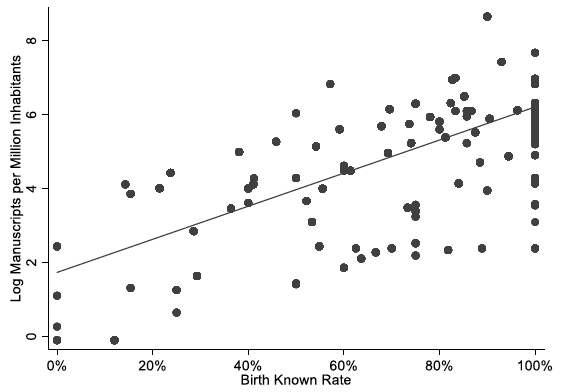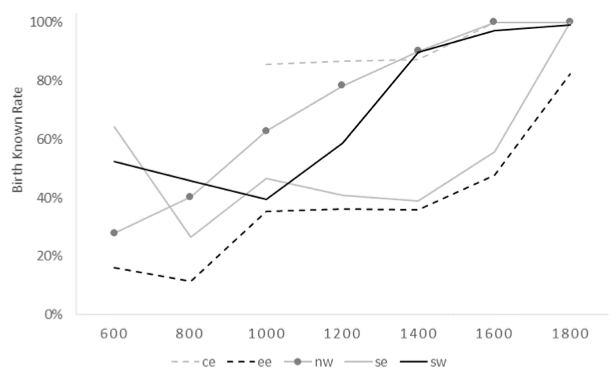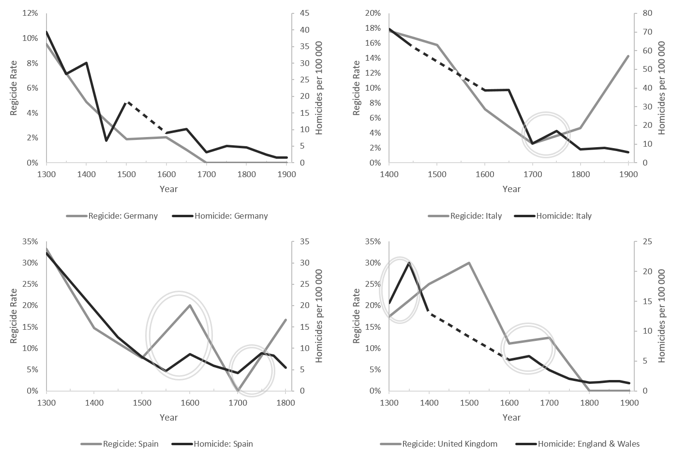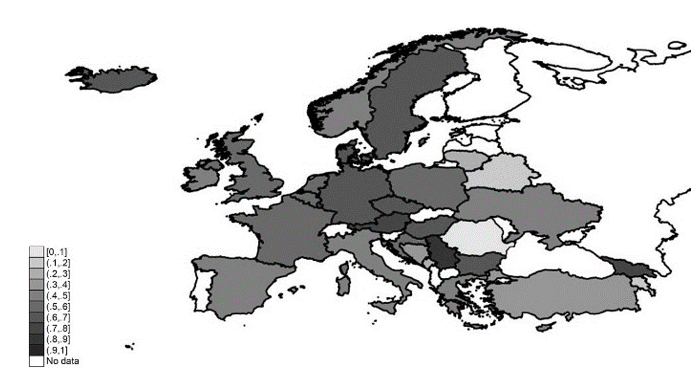The EU is currently threatened by disintegration, not only in its West and South, but also in the East as populist parties in Poland, Hungary and elsewhere entice voters with their EU integration-sceptic attitudes. Krastev and Holmes (2019) recently argued that the success of anti-European populists has been enabled by East European voters’ and politicians’ fear of losing their youth to rich EU countries in the centre and west. The lower standard of living in Eastern (and East-Central) Europe has already resulted in population losses of more than 20% in some countries; most of these migrants are young (i.e. aged 20–30), well-educated and energetic.
The anti-European rhetoric may or may not be a futile attempt to enact changes in EU policy, but the underlying economic differences between the East and West remain a challenge. The gap in living standards may grow even stronger in the future if this migration of youth – and the subsequent brain drain – continues.
One important background question that economic historians have not yet fully answered is: during which historical period did Eastern Europe fall behind relative to the West? Has this always been the case? What caused it? Acemoglu and Robinson (2012) would probably answer the last question by describing the institutional structure of Eastern Europe as less ‘inclusive’ and insufficiently protective of property rights, while Malinowski (2016) recently argued that institutional development might be endogenous (see also Bosker et al. 2013). However, the real hurdle to understanding East and West European development is the scarcity of data that reach far back in time.
In a recent paper (Keywood and Baten 2019), we trace human capital among the elite over the last 1,500 years, looking at one of its core components, namely, elite numeracy. We further suggest that the role of violence, although inextricably linked to the majority of previously proposed explanations for economic development, has been under-researched and largely neglected in the literature (exceptions are Cummins 2017 and Findlay and O’Rourke 2009). In the same way that elite numeracy has increased over time and allowed for technological progress and economic development, a ‘civilising process’ has taken place globally, as levels of violence have plummeted from what we would consider utter anarchy in centuries past to modern levels (Elias 1939).
In a study spanning all of Europe from 500 to 1900 CE, we explore the co-evolution of non-violent behaviour and numeracy among elites, concluding that the absence of violence played a significant role in economic development through elite numeracy formation.
To approach this topic, we rely on proxy indicators, since standard indicators of violence and elite numeracy are not available for early periods of European history. Hence, a new indicator is implemented that is able to trace the development of elite numeracy over the very long term: the share of rulers for whom a birth year is reported in conventional biographical sources. We reason that a ruler’s birth year was regularly reported and entered into historical chronologies only if elite bureaucracies were capable of processing numerical information with ease; otherwise, it was simply forgotten and left unrecorded.
Consequently, the elite numeracy levels of the rulers themselves are not estimated, but rather whether the bureaucratic elite around them held basic numerical skills and was interested in using them. Such a measurement may seem simplistic, but the ‘birth-known’ indicator is highly correlated to alternative but established proxies for human capital, thus motivating the analysis (Figure 1; more details in Keywood and Baten 2019).
Figure 1 Comparison of two proxies of elite human capital: Monastery manuscripts per capita vs elite numeracy, 700–1500 CE
Source: Buringh and van Zanden (2009).
Southeastern Europe was the first region to undergo the transformation from scarce to near-universal basic numeracy, led by the East Roman Empire (Figure 2). Shortly afterwards, the Southwest became slightly superior. All European regions experienced a period of approximate parity around the year 1000, while Northwestern and Central Europe did not begin to display their divergent patterns before the High Middle Ages. After this period, both the East and Southeast entered into decline, and by 1400, a development path was firmly established that divided the East and the West of the continent until parity was restored during the 19th century. This is the moment in history when the East–West divergence occurred, at least in terms of elite numeracy.
Figure 2 Trends in elite numeracy
Notes: Central Europe (ce), Eastern Europe (ee), North-western Europe (nw), South-eastern Europe (se) and South-Western Europe (sw).
After establishing this new indicator for elite numeracy and exploring its development over time, we study specific correlates and potential determinants of elite numeracy. In particular, we address the issue of whether either military violence or interpersonal violence among the ruling faction was related to elite numeracy. Two proxy indicators are also used: the share of rulers who were killed in battles as an estimate of military violence; and cases of interpersonal violence estimated by the share of murdered rulers outside of battles – if killed, rulers were typically murdered by their own family members or by competing nobility (see Baten 2018 on the Middle East; Eisner 2011 on Europe). Interestingly, the rate of regicide is closely linked to the homicide rate from among the general population, potentially allowing for wider conclusions than simply an analysis of elites (see Figure 3 for examples).
Figure 3 Examples of regicide and homicide rates
Notes: The circles indicate simultaneous increases, showing that this relationship is not simply due to time trends. Source: Eisner (2014).
We also assess a number of potential factors that might either determine or interact with elite numeracy, including agricultural specialisation, institutional quality, urbanisation, religion, and geographical traits, and find that violence had the strongest and most consistent impact on elite numeracy. A one standard deviation increase in the proportion of battle deaths is associated with an approximately 5.5 percentage point decline in elite numeracy, while a one standard deviation increase in the regicide rate is associated with an approximately 8 percentage point decrease in elite numeracy.
However, the other factors also have a modest influence on elite numeracy. When the control of rulers is constrained by elective systems of succession, which indicate greater institutional quality through a preference for political participation, elite numeracy is higher on average. Likewise, the existence of a substantial Jewish minority is associated with greater elite numeracy, possibly due to human capital spillovers from Jewish communities to the generally Christian elite. Finally, regions that specialised in cattle farming developed greater elite numeracy than grain-intensive regions. A growing body of literature finds a relationship between agricultural specialisation in animal husbandry and the relatively strong economic position of women, which might also have influenced human capital formation through gender equality and female autonomy (Alesina et al. 2013, de Pleijt et al. 2016, Voigtländer and Voth 2013, Baten et al. 2017).
Given the challenges in identifying causality, we prefer to describe the history of European violence and elite numeracy as a co-evolutionary process, but a clearer depiction of causality can be obtained through an instrumental variable approach. We use the relatively exogenous import of violence from the Central Asian nomadic invasions of ca. 800–1000 and 1200–1400, reasoning that these invasions acted contagiously and motivated additional intra-European violence. Interestingly, Europe did not experience invasions from Central Asia during the High Middle Ages, and according to our estimates, European violence did not follow any East–West pattern at this time. If anything, Eastern Europe was more peaceful (Figure 4).
Figure 4 Regicide rate (1000–1300)
By using this ‘natural experiment’ characteristic of the nomadic invasions, we observe causal effects from violence to elite numeracy, emphasising the impact of violence on elite numeracy formation, and contribute to filling some of the gaps in economic development literature.
In conclusion, this study finds that East–West differences have existed for a long time. However, during the first 500 years of this analysis, no substantial differences in elite numeracy existed, showing that geography or other time-invariant factors did not play a role. Violence and the institutional changes caused by the threat of violence mattered the most: after the trauma of nomadic invasions, Eastern societies created institutions primarily aimed at defence rather than economic development, even over the following centuries when the threat had long disappeared. The lack of economic success from this defence strategy certainly provides insights for the European populism debate.
References
Acemoglu, D, and J Robinson (2012), Why nations fail: The origins of power, prosperity and poverty, New York: Crown Publishing Group.
Alesina, A, P Giuliano and N Nunn (2013), “On the origins of gender roles: Women and the plough”, The Quarterly Journal of Economics 128(2): 469–530.
Allen, R (2001), “The Great Divergence in European wages and prices from the Middle Ages to the First World War”, Explorations in Economic History 38(4): 411–47.
Baten, J (2018), “Elite violence and elite numeracy in the Middle East since the early Middle Ages”, working paper, University of Tübingen.
Baten, J, M Szołtysek and M Campestrini (2017), “‘Girl Power’ in Eastern Europe? The human capital development of Central-Eastern and Eastern Europe in the seventeenth to nineteenth centuries and its determinants”, European Review of Economic History 21(1): 29–63.
Bosker, M, E Buringh and J van Zanden (2013), “From Baghdad to London: Unravelling urban development in Europe, the Middle East, and North Africa, 800–1800”, Review of Economics and Statistics 95(4): 1418–37.
Broadberry, S (2013), “Accounting for the great divergence”, Economic History Working Papers 184/13, London School of Economics and Political Science.
Buringh, E, and J Van Zanden (2009), “Charting the ‘rise of the West’: Manuscripts and printed books in Europe, A long-term perspective from the sixth through eighteenth centuries”, The Journal of Economic History 69(2): 409–45.
Cummins, N (2017), “Lifespans of the European elite, 800–1800”, The Journal of Economic History 77(2): 406–39.
De Pleijt, A, and J van Zanden (2016), “Accounting for the ‘Little Divergence’: What drove economic growth in pre-industrial Europe, 1300–1800?”, European Review of Economic History 20(4): 387–409.
Diebolt, C, and F Perrin (2013), “From stagnation to sustained growth: The role of female empowerment”, American Economic Review 103(3): 545–9.
Eisner, M (2011), “Killing kings: Patterns of regicide in Europe, AD 600–1800”, British Journal of Criminology 51(3): 556–77.
Eisner, M (2014), “From swords to words: does macro-level change in self-control predict long-term variation in levels of homicide?”, Crime and Justice 43(1): 65–134.
Elias, N (1939), Über den Prozess der Zivilisation. soziogenetische und psychogenetische Untersuchungen, Basel: Verlag Haus zum Falken.
Findlay, R, and K O'Rourke (2009), Power and plenty: trade, war, and the world economy in the second millennium, Princeton: Princeton University Press.
Keywood, T, and J Baten (2019), “Elite violence and elite numeracy in Europe from 500 to 1900 CE: A co-evolution?”, CEPR Discussion Paper DP14013.
Krastev, I, and S Holmes (2019), The light that failed: A reckoning, London: Allen Lane.
Malinowski, M (2016), “Serfs and the city: Market conditions, surplus extraction institutions, and urban growth in early modern Poland”, European Review of Economic History 20(2): 123–46.
Voigtländer, N, and H J Voth (2013), “How the West ‘invented’ fertility restriction”, American Economic Review 103(6): 2227–64.
